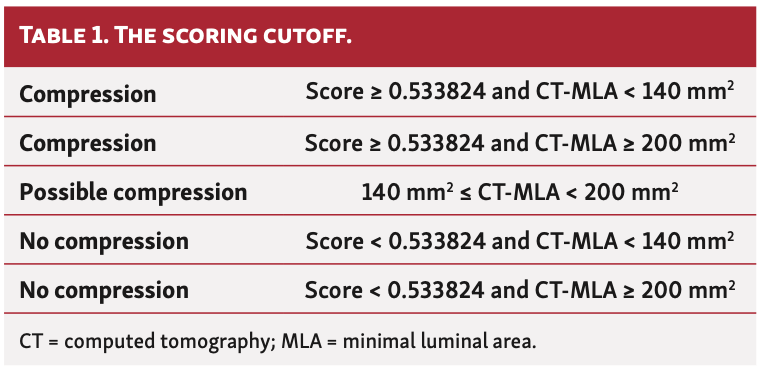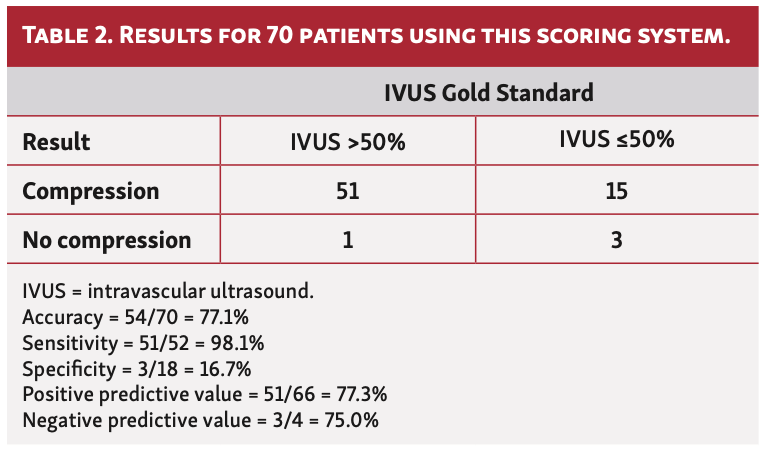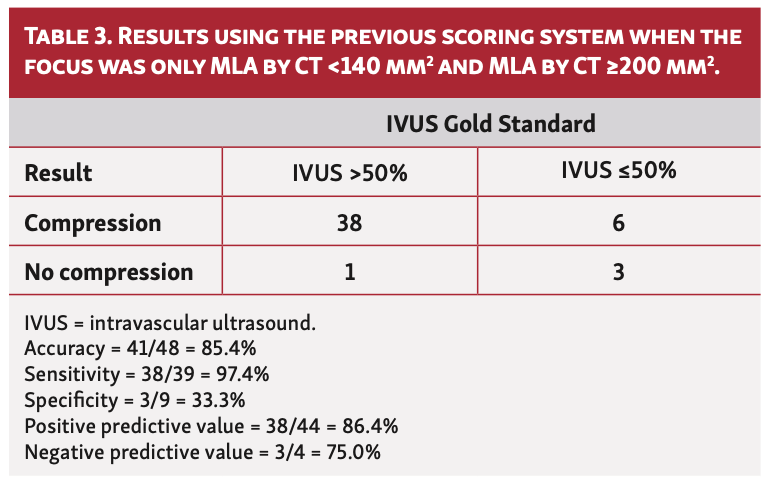ADVERTISEMENT
Predicting Significant Iliac Vein Compression Using a Probability Scoring System Derived From Minimal Luminal Area on Computed Tomography Angiography in Patients 65 Years of Age or Younger
Abstract
Background. The presence of 50% or more stenosis on intravascular ultrasound (IVUS) is considered diagnostic of iliac vein compression (ILVC) by most operators. We have previously developed a scoring system combining minimal luminal area (MLA) at the compression site and age to predict ILVC as seen on IVUS. We present a revised and improved scoring system following an additional number of patients and limited to patients 65 years of age and younger. Methods. Patients were included from retrospective (n = 52) and prospective (n = 18) registries of consecutive patients who underwent computed tomography angiography (CTA) of the pelvis with venous filling and IVUS within a few weeks apart to evaluate for symptomatic ILVC at a single cardiovascular practice. Quantitative vascular analysis was performed on all images obtained. MLA and age were used to calculate a score derived from a previously published logistic regression formula. Patients >65 years in age were excluded. The predicted findings from the score were compared with the actual presence of compression on IVUS. The revised scoring system is based on a score of < or ≥ 0.533824 and MLA (mm2) of <140, ≥140 to <200, and ≥200. The negative predictive value (NPV) and positive predictive value (NPV and PPV) of each cut-off in predicting ILVC on IVUS were calculated. Results. A total of 70 symptomatic patients were included (mean age, 52.6 ± 12.3 years). The model offered the following: accuracy = 54/70 (77.1%); sensitivity = 51/52 (98.1%); specificity = 3/18 (16.7%); PPV = 51/66 (77.3%); and NPV = 3/4 (75.0%). Conclusion. A scoring system using MLA on CTA and age provides a fairly accurate diagnostic test to predict the presence of significant ILVC as seen on IVUS.
J INVASIVE CARDIOL 2021;33(1):E16-E18. doi:10.25270/jic/20.00477
Key words: computed tomography angiography, iliac vein compression, intravascular ultrasound, May-Thurner, scoring system, venous stent
Ileofemoral vein stenting for iliac vein compression (ILVC) is effective in reducing symptoms of pain and swelling in the affected limb.1-6 The gold standard in diagnosing ILVC is intravascular ultrasound (IVUS); however, IVUS requires an invasive procedure. Computed tomography (CT) angiography is a viable non-invasive imaging modality that has been shown to define the severity of the compression. However, CT angiography evaluation has been mostly semiquantitative and therefore is likely to be subject to significant interobserver and intraobserver variability. In this study, a scoring system was derived using quantitative CTA and IVUS findings in a larger cohort of patients than we previously published,7 with 18 new patients added prospectively. In addition, the scoring cut-off limit was improved upon from the previous model to improve its accuracy in predicting ILVC.
Methods
All patients from October 3, 2013 to June 1, 2019 who underwent CTA of the pelvis with venous filling, IVUS, and venography within a few weeks apart to evaluate for symptomatic ILVC from a single cardiovascular practice were reviewed. The study was approved by the institutional review board of the Genesis Health System. Quantitative vascular analysis was performed on all images obtained. Bivariate analysis was performed on all variables to determine differences between patients with ILVC vs not as seen on IVUS (gold standard). The best model was selected based on individual significance of variables, overall model significance (P<.0500) and using the Hosmer-Lemeshow test to evaluate goodness of fit (P>.0500). From the selected model, a scatterplot of MLA by CT vs age indicated MLA by CT <140 mm2 maximized true positives and MLA by CT ≥200 mm2 maximized true negatives. When 140 mm2 ≥ MLA by CT < 200 mm2, more false positives were introduced. Model score cut-offs were tested using receiver operating characteristic curve analysis and patient-specific data to ensure the greatest accuracy. Based on the model and the revised scoring system, the data were developed in an app that underwent beta-testing successfully.
Results
The prior published model was based on a total of 96 patients reviewed retrospectively (62.5% women; mean age, 62.3 ± 14.8 years).7 Age and MLA on CTA were selected as the strongest model. The Hosmer-Lemeshow test indicated the model was a good fit (P=.7500). The model correctly classified the gold standard or disease 73.9% of the time. The significant variables in the model were MLA by CT (.0550) and age (.0110).
The model equation is:

The derived score is:

In this report, 30 prospective patients were added to the prior model to improve on the scoring and MLA by CTA cut-offs. Patients 65 years and older confounded the accuracy of predicted compression and therefore the model was limited to patients <65 years of age. Thus, the analysis was limited to 70 patients who were 65 years and younger (61.4% women; mean age, 52.6 ± 12.3 years). MLA by CT ≥140 mm2 and <200 mm2 indicated a gray zone for accuracy or possible compression (Figure 1). The prevalence of MLA ≤140 mm2 and >200 mm2 by CT was 39/48 (81.3%).
The scoring cut-off is shown in Table 1. When applying these cut-offs, the results are shown in Table 2. As a comparison, Table 3 shows the results when using the previous scoring system. The 1 false negative greatly influenced the negative predictive value.
Discussion
ILVC is present in 20%-25% of people. Currently, only symptomatic ILVC is treated with iliac vein stenting to reduce symptoms of pain and swelling.8 It is unclear, however, whether symptoms are secondary to ILVC vs other medical conditions such as venous reflux or lymphedema. Typically, IVUS is the gold standard to confirm the diagnosis, which requires an invasive evaluation. CTA has been used as an alternative to IVUS, but may overestimate or underestimate the compression severity. Using a predictable measurement on CTA, such as MLA at the compression site, as well as patient age, the model provides a predictable scoring system that is reproducible and less subject to intra- or interobserver variability. Using various measurements on CTA and clinical variables, we have previously shown that MLA and age are the only independent predictors of ILVC as seen on IVUS.7 The model under the current revised scoring system provided a positive predictive value of 77.3% and a negative predictive value of 75.0%. An MLA of <140 mm2 and ≥200 mm2 seems to predict the presence or absence of a significant ILVC in a symptomatic population as seen on IVUS (>50%), respectively. These cut-off limits are also dependent on the patient’s age on the regression model.
Study limitations. This model applies to symptomatic patients <65 years old. A larger number of patients in a real-world setting is needed to further validate this model.
Conclusion
A scoring system using age and CTA provides a fair diagnostic test to predict the presence of significant ILVC as seen on IVUS. These data will be incorporated into an app that will allow free access to this model by providers evaluating patients for ILVC.
From the Midwest Cardiovascular Research Foundation, Davenport, Iowa.
Disclosure: The authors have completed and returned the ICMJE Form for Disclosure of Potential Conflicts of Interest. Dr Shammas reports educational and research grants and is a trainer for Boston Scientific and Bard. The remaining authors report no conflicts of interest regarding the content herein.
Final version accepted July 27, 2020.
Address for correspondence: Nicolas W. Shammas, MD, MS, Research Director, Midwest Cardiovascular Research Foundation, 1622 E. Lombard Street, Davenport, IA 52803. Email: shammas@mchsi.com
- McMurrich JP. The occurrence of congenital adhesions in the common iliac veins and their relation to thrombosis of the femoral and iliac veins. Am J Med Sci. 1908;135:342-346.
- May R, Thurner J. The cause of the predominantly sinistral occurrence of thrombosis of the pelvic veins. Angiology. 1957;8:419-427.
- Cockett FB, Thomas ML. The iliac compression syndrome. Br J Surg. 1965;52:816-821.
- Kibbe MR, Ujiki M, Goodwin AL, Eskandari M, Yao J, Matsumura J. Iliac vein compression in an asymptomatic patient population. J Vasc Surg. 2004;39:937-943.
- Abboud G, Midulla M, Lions C, et al. “Right-sided” May-Thurner syndrome. Cardiovasc Intervent Radiol. 2010;33:1056-1059.
- Kölbel T, Lindh M, Akesson M, Wassèlius J, Gottsäter A, Ivancev K. Chronic iliac vein occlusion: midterm results of endovascular recanalization. J Endovasc Ther. 2009;16:483-491.
- Shammas NW, Shammas GA, Jones-Miller S, et al. Predicting iliac vein compression with computed tomography angiography and venography: correlation with intravascular ultrasound. J Invasive Cardiol. 2018;30:452-455.
- Radaideh Q, Patel NM, Shammas NW. Iliac vein compression: epidemiology, diagnosis and treatment. Vasc Health Risk Manag. 2019;15:115-122.






















